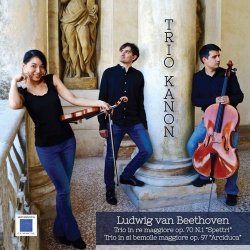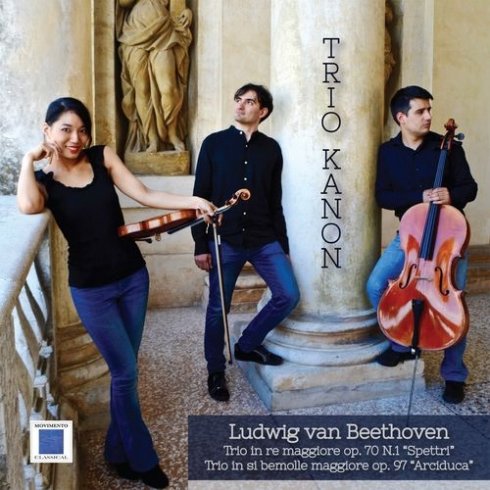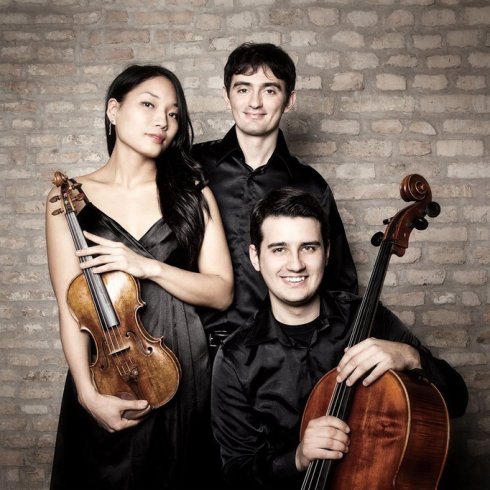

For Beethoven, chamber music was an ex ceptional testing ground: in the piano so natas, in the string quartets and in the trios he looked for new technical-instrumental solutions, he extended the boundaries ofthe form and he tried unusual combinations of timbre. He then made the best of this ex perience in big orchestra! works, with un equalled results. At Mozart e Haydn times, the highest mas ters ofthe "classica! style", in the trio, very popular genre among Viennese middle class, the keyboard instrument was the undoubted protagonist, while the violin stood out in the sung episodes, and the celio played a more subordinate role, almost al ways doubling the bass line. Little by little Beethoven got rid of that model, formulating a composition which could guarantee the three "actors" a more similar role. The trio op.70 n.1 opens and closes with two movements (I and III) in a bright and determined manner, where the instrumental virtuosity and the freshness of the themes prevail. The Allegro and the Presto are like a shell, hiding their secret at the centre, the Largo assai ed espressivo, which is the main heart ofthe trio. We immediately understand the subtitle "Ghost" which amplified the success of this piece: the strings whisper fragments of a melody which develops on the arpeggio in D minor, while the piano intervenes with melancholic incisions. The second theme is more expressive and is first entrusted to the cello, then to the violin, in a desperate crescendo, leading it back to the first theme, with the cello accompanied by a moumful tremor ofthe piano. The piece develops slowly, maintaining a tension giv en by the unconventional treatment of the dynamic and of the harmonies, blooming sometimes in lyrical and dramatic parenthe ses. It is revolutionary music, which crosses the formai and expressive boundarìes ofthe epoch. The trio op. 97, composed in 181 I, was published in 1816 dedicated to the Arch duke Rodolfo of Austria, friend and sup porter, praised even in the name of the so nata "Hammerklavier" and of the Solemn Mass. Beethoven develops the research of new technical and expressive means, parallel to the development of keyboard instruments produced by Broadwood and other compa nies, which at the beginning ofthe 19th cen tury produced pianos with more solid mechanical parts, with a stronger sound and an extension of six octaves: necessary condi tions to imagine music of a stronger impact and duration. As a result, the proportions of this trio are symphonic; Beethoven tries to overstep every kind of genre and opens new paths which enlighted the way to Schubert and Brahms after him. The Allegro moderato is a piece with a wide scope: the first theme, aìry and singable is entrusted to the piano but is violently inter rupted by the introduction ofthe strìngs and the cadence of the celio. The second theme is instead in G major, the detached and hesi tating movement that sounds like the incipit of the Fourth piano concerto. The contrast between noble lyricism and the more rhyth mic and syncopated sections characterizes the whole trio. The Scherzo has a dancing character, even though it has with a centrai section with a religious fugato, opened with a mezza voce on the celio, and followed by a crescendo that flows into the rugged arpeggi ofthe pi ano and the sound offanfare ofthe strings. The slow movement is perhaps the most sublime piece of the trio: an Andante can tabile ma pero' con moto structured as a theme with five variations. A bright choral in D major is first presented by the piano then by the strings, but at the beginning of the first variation it remains just a memory, an evocation suggested by the extremely light accompaniment of the piano and the increasingly more articulate interventions ofthe strings. The last variation is a sort of recapitulation: the theme reappears, once more recogniz able, in pianissimo, before the finally pas sionate chant of the strings, stressed by the "Schubertian" chords of the piano, leads us to a more peaceful conclusion. The final Allegro moderato begins without any interruption: the character is rustic, al most sneering and the warm and comforting sonority of the Andante cantabile is only a memory. The motif is announced by the piano and made sharper by the trills, acciaccaturas and syncopated rhythms. It is a lively Ronda' in a classica! form, but in the finale a disrespectful tarantella in A major (a very distant key) insinuates in pianissimo and grows bolder step by step, until the conclusive pleading in tempo Piu' presto, that leads back to the "right" tonic of B flat major.


TRIO KANON
Diego Maccagnola, pianoforte
Lena Yokoyama, violino
Alessandro Copia, violoncello
Trio Kanon, (the name refers to the Canone but simultaneously is coming from the union of two Japanese words: “Ka” – “Flower” and “On”– “Music” so literally “Flourishing Music”) arise in summer 2012 from the friendship between three musicians with the same purpose to make music together. With this premise in 2012 Lena, Alessandro and Diego started their chamber music experience building their repertoire under the guide of the Trio di Parma (Alberto Miodini, Ivan Rabaglia, Enrico Bronzi) at the International Chamber Music Academy in Duino, founded by the Trio di Trieste in 1989. Trio Kanon won the 1st Prize, the Audience Prize and the Special Prize for the best Brahms at the International Chamber Music Competition Pinerolo & Torino 2018, the 2nd Prize (1st not assigned) at the On Stage International Chamber Music Competition 2017 and the 1st Prize and the Audience Prize at the Rospigliosi Chamber Music Competition 2015. Trio Kanon was the best group in the Trondheim International Chamber Music Academy for Piano Trios 2014 and in 2015 won the “Chamber Music Award”, sponsored by the Haydn institute and the “University of Music and Performing Arts” in Vienna, as best chamber music group at the “Internationale Sommer Akademie Prag-Wien-Budapest”. Recent concert appearances has been at the “Fenice” theatre in Venice, the “Gromo Losa” palace in Biella, the Teatro Verdi in Trieste, the Teatro Vittoria in Turin, the teatro Giacosa in Ivrea, the new “Arvedi” Auditorium in Cremona, Palazzo Ducale and Palazzo Te in Mantova during the “Mantova Chamber Music Festival”, the Portogruaro Festival and abroad United Kingdom, Norway, China, Croatia, Austria and United States with great success in public and critics. In 2014 the Trio attended the masterclasses with Alexander Lonquich at “Accademia Chigiana” in Siena, with Robert Cohen at Snape Maltings (Uk), with Hatto Beyerle, Miguel Da Silva and Annette von Hehn (Atos Trio) at Trondheim Chamber Music Academy 2014 (Norway), with Oliver Wille at ProQuartet in Paris and at the Internationale Konzertarbeitswochen in Goslar (Germany) and with Avedis Kouyomdijian, Johannes Meissl, Anita Mitterer, Peter Nagy, the Talich Quartet at ISA2015 summer academy in Semmering and Reichenau an der Rax (Vienna). In 2015 Trio Kanon has been invited as group in residence at Snape Maltings (UK) performing twice at the Jubilee Hall in the prestigious “Aldeburgh Music 2015” festival. During 2016 Trio Kanon has been booked for a tour in China performing at the Parkview Green Museum in Beijing for the Italian Culture Institute.In 2017 Trio Kanon made his debut in Japan with concerts at the Music Salon Amadeus in Kobe, the Aqua Cultural Center in Toyonaka and the Petit L-Hall in OsakaThey recently recorded for prestigious review “Amadeus” and “Movimento Classical” label music by L. v. Beethoven.
